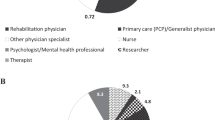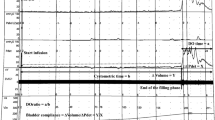Abstract
Study design:
Retrospective study.
Objectives:
To analyze the neurogenic bladder characteristics and treatment approaches in patients with upper and lower cervical spinal cord injury (SCI) in order to make proper and reasonable decisions to the relevant patients.
Setting:
Rehabilitation center in Ankara, Turkey.
Method:
Ninety patients with cervical SCI were included. The urodynamic analyses of the patients were conducted retrospectively by using the urodynamic laboratory records. The patients were divided into two groups as the upper cervical SCI (UCSCI) group (C1-C5) and lower cervical SCI (LCSCI) group (C6-C8).
Results:
In this study, 82 male (91.1%) and 8 (8.9%) female patients were included. There were 51 UCSCI patients with the mean age of 34.2±16.1 years and 39 LCSCI patients with the mean age of 30.4±12.5 years. Detrusor overactivity and preservation of the bladder-filling sensation were significantly more frequent in the UCSCI group than in the LCSCI group (P=0.048, P=0.000 respectively). Moreover, there were statistically significant differences between the groups regarding the bladder-emptying methods, residual volume and the frequency of anticholinergic and alpha blocker use (all P<0.05). No significant difference was found between the groups regarding the frequency of autonomic dysreflexia, detrusor hypocompliancy and the bladder-storage and -emptying disorders (all P>0.05).
Conclusion:
Our results demonstrate that there are differences in the upper and lower SCI cases in terms of neurogenic bladder characteristics and treatment approaches.
Similar content being viewed by others
Log in or create a free account to read this content
Gain free access to this article, as well as selected content from this journal and more on nature.com
or
References
Sekhon LH, Fehlings MG . Epidemiology, demographics and pathophysiology of acute spinal cord injury. Spine 2001; 26 (24 Suppl.): S2–12.
Karacan I, Koyuncu H, Pekel Ö, Sümbüloğlu G, Kırnap M, Dursun H et al. Traumatic spinal cord injuries in Turkey: a nation-wide epidemiologic study. Spinal Cord 2000; 38: 697–701.
Lee YH, Creasey GH, Lim H, Song J, Song K, Kim J . Detrusor and blood pressure responses to dorsal penile nerve stimulation during hyperreflexic contraction of the bladder in patients with cervical cord injury. Arch Phys Med Rehabil 2003; 84: 136–140.
Morita H, Sazawa A, Kanno T, Keyanagi T . Long term urinary prognosis of cervical cord injury patients. Paraplegia 1994; 32: 30–35.
Kaplan SA, Chancellor MB, Blaivas JG . Bladder and sphincter behavior on patients with spinal cord lesions. J Urol 1991; 146: 113–117.
Ando M . Neurogenic bladder in patients with cervical cord compression disorders. Nihon Hinyokika Gakkai Zasshi 1990; 81: 243–250.
Wyndaele JJ . The normal pattern of perception of bladder filling during cystometry studied in 38 young healthy volunteers. J Urol 1998; 160: 479–481.
Wyndaele JJ, Wachter SD . Cystometrical sensory data from a normal population: comparison of two groups of young healthy volunteers examined with 5 years interval. Eur Urol 2002; 42: 34–38.
Ersöz M, Akyüz M . Bladder filling sensation in patients with spinal cord injury and the potential for sensation-dependent bladder emptying. Spinal Cord 2004; 42: 110–116.
Consortium For Spinal Cord Medicine, Clinical Practice Guidelines, August 2006.
Guidelines on Neurogenic Lower Urinary Tract Dysfunction. European Association of Urology 2012.
Ersöz M . Neurogenic bladder and bowel in pediatric spinal cord injury patients. Turk J Phys Med Rehab 2008; 2: 75–80.
Robertson AS, Griffiths CJ, Ramsden PD, Neal DE . Bladder function in healthy volunteers: ambulatory monitoring and conventional urodynamic studies. Br J Urol 1994; 73: 242–249.
Abdel-Rahman M, Coulombe A, Devroede G, Toppercer A, Duguay C, Lapointe L et al. Urorectodynamic evaluation of healthy volunteers. Urology 1982; 19: 559–564.
Dmochowski R . Cystometry. Urol Clin North Am 1996; 23: 243–252.
Ersöz M, Tunç H, Akyüz M, Özel S . Bladder storage and emptying disorder frequencies in hemorrhagic and ischemic stroke patients with bladder dysfunction. Cerebrovasc Dis 2005; 20: 395–399.
DeVivo MJ, Krause JS, Lammertse DP . Recent trends in mortality and causes of death among persons with spinal cord injury. Arch Phys Med Rehabil 1999; 80: 1411–1419.
Kirshblum S . Rehabilitation of SCI. In: DeLisa JA, Gans BM (eds). Physical Medicine and Rehabilitation, Principles and Practice 4th edn. Lippincott Williams & Wilkins: Philadelphia, PA, USA. 2005 pp 1715–1751.
Cardenas DD, Mayo ME . Management of bladder dysfunction. In: Braddom RL (ed.). Physical Medicine and Rehabilitation 4th edn. Saunders Elsevier: Philadelphia, PA, USA. 2010 pp 626.
Author information
Authors and Affiliations
Corresponding author
Ethics declarations
Competing interests
The authors declare no conflict of interest.
Rights and permissions
About this article
Cite this article
Sayılır, S., Ersöz, M. & Yalçın, S. Comparison of urodynamic findings in patients with upper and lower cervical spinal cord injury. Spinal Cord 51, 780–783 (2013). https://doi.org/10.1038/sc.2013.83
Received:
Revised:
Accepted:
Published:
Issue date:
DOI: https://doi.org/10.1038/sc.2013.83
Keywords
This article is cited by
-
Urodynamic findings and therapeutic approaches for neurogenic lower urinary tract dysfunction in patients with thoracic spinal cord injury
Irish Journal of Medical Science (1971 -) (2023)
-
Combining different evaluations of sensation to assess the afferent innervation of the lower urinary tract after SCI
Spinal Cord (2021)
-
Autonomic dysreflexia and repeatability of cardiovascular changes during same session repeat urodynamic investigation in women with spinal cord injury
World Journal of Urology (2016)
-
Iatrogenic urological triggers of autonomic dysreflexia: a systematic review
Spinal Cord (2015)
-
Urodynamic findings, bladder emptying methods and therapeutic approaches in patients with upper lumbar and lower lumbar–sacral spinal cord injury
Neurological Sciences (2015)



